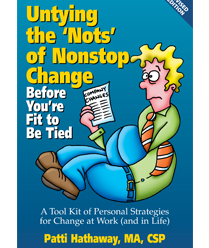A leader is a professional who is responsible for a standard of care of the organization and its stakeholders (employees, customers, investors). The use of the typical appraisal process is a breach in that standard of care. Its use causes injury to employees, customers and investors in ways that often cannot be measured. The injuries are emotional and are manifested in the lower employee engagement, lower productivity, poor quality and poor attitude.
Most Human Resource professionals, CEOs and attorney attribute the failure of the typical performance appraisal to poor management skills and or poor training of those managers who must implement it. This is incorrect. The techniques used by managers who conduct the typical appraisal meetings are the cause of failure. The book makes a strong case that it’s the design and the premises which underlie that design which are flawed. The book explains how these flaws cannot be overcome by even the most skilled of managers. The flaws can only be fixed by leadership and any leader who ignores this responsibility is guilty of malpractice. It’s in the assumptions and decisions of the leadership that must change first to make way for a replacement which more closely aligns with natural law and with the requirements of our “new” knowledge economy.
Appraisals attempt to measure the performance of an individual in a complex system. With stories and case studies this book demonstrates how it’s impossible to accurately separate the performance of an individual part from the influence of a complex system. Any attempt to do so is guesswork, opinion, bias and malpractice.
The book makes a case for a replacement process which is consistent with systems thinking. This alternative, The Complete Performance Improvement Process (CPIP), enables leaders to build trust between the individuals and not damage it as the typical appraisal does. This alternative enables leaders and the employees to act as partners and colleagues to solve process issues instead of the judge and the judged.
The alternative (CPIP) heaps a greater sense of responsibility on both the employee and the leader. These responsibilities are of higher quality and create higher standards of behavior and performance. The alternative demands employees are treated like adults and not like children. It enables managers to behave like facilitators and not omniscient parents and/or arrogant biased judges.
CPIP provides a process for immediate feedback and that process enables anyone (not just managers) to deliver that feedback without fear of retribution and without bias. The feedback is delivered solely for the purpose of increasing trust and/or improving learning both of which will lead to improved performance. CPIP discourages (and can prevent) feedback for the purpose of manipulation and for personal gain at the expense of the system performance.
CPIP facilitates the creation of joy at work for all employees. It’s a tool that enable leaders to create an environment that fosters fun, trust, the love of learning, innovation, productivity, continuous improvement, and outstanding results. It unleashes employee engagement. It also puts positive pressure on every one to improve their leadership skills. CPIP does all of this and it has the potential to do even more. The book explains the foundational theory, suggestions on how to implement the new process and ideas on how to sustain it. It also contributes to a vision of the future which includes self-organizing teams and a self-organizing system.










